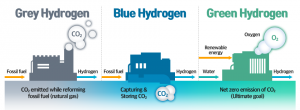From an Article by Audrey Carleton, VICE Communications, February 8, 2022
The fossil fuel industry has a new plan for Appalachia: Blue hydrogen.
An alliance between some of the largest corporations in the energy business — Shell, General Electric Gas Power, EQT Corporation, Equinor, Mitsubishi, US Steel and Marathon Petroleum — announced in a press release late last week their plan to create a “hydrogen industrial hub” in Ohio, Pennsylvania, and West Virginia. Their plan is to work with local stakeholders in the process, creating “a national model for sustainable energy and production systems.”
The companies are putting their faith in an element that’s gained traction as an energy form in recent months, as the bipartisan infrastructure bill includes billions of dollars to build out clean hydrogen energy development. Hydrogen is also the most abundant element in the universe, existing in water, alcohols, and the like.
Producing hydrogen as an energy source requires separating H atoms from other elements in the molecules where it naturally occurs (so, removing the H from H2O, for example). This is most commonly done commercially using steam to separate hydrogen from methane in natural gas; the finished product is referred to as ‘blue hydrogen,’ because it is emissions-free when burned, but is made with polluting sources of energy. (Its green counterpart, ‘green hydrogen’ is made by separating hydrogen atoms from water using renewable sources of energy, like wind and solar.)
Matt Kelso, manager of data and technology at the non-profit environmental watchdog FracTracker Alliance sees the investment in hydrogen as “an extension of the existing polluting industries, by the exact same companies that are polluting our air, land, and water today.”
“It is an excuse to keep drilling, obfuscated under a new identity, in an environment where there is increasing awareness of the damages that oil and gas extraction has caused to the region,” said Kelso, who lives in Pittsburgh, near southwest Pennsylvania’s oil and gas hub.
The plan will capitalize on the region’s natural gas stores, largely trapped in the Marcellus Shale geologic formation, untapped during the fracking boom of the early 2010s. The technique, which involves thrusting drilling fluid deep into rock formations, first vertically, then horizontally, to reach gaps in which natural gas is stored and release it. At the time, fracking promised to resuscitate the oil and gas industry, bringing an economic renaissance to the region.
In reality, these plans didn’t pan out: Actual job numbers paled in comparison to those promised. A 2021 economic analysis by the non-profit think tank Ohio River Valley Institute found that jobs in Appalachian fracking counties climbed by merely 1.6 percent in the 2010s, compared to the 450,000 jobs that industry estimates from the early 2010s laid out. It also led to an oversupply of natural gas that the industry is now trying to offload (most notably by pushing plastics).
The companies are positioning the move as an environmentally-sound one, or a way to achieve “aggressive net zero carbon goals,” Bill Newsom, president and CEO of Mitsubishi Power said in a press release. In fact, the fossil fuel industry more broadly has rallied around using carbon capture and sequestration as a technique to eliminate emissions from steam-methane reforming in the hydrogen production process.
These emissions are substantial. An August, 2021 report out of Cornell and Stanford Universities found that the carbon footprint that comes with creating blue hydrogen is 20 percent larger than that of burning natural gas and coal for heat and 60 percent greater than burning diesel oil for the same purpose.
Thus, carbon capture and storage — in which carbon dioxide is collected at the source of emissions and shot underground into stores — is essential to the fossil fuel companies’ plan if it is to be ‘net zero.’ But CCS comes with its own set of risks; pipelines carrying captured carbon have, in the past, exploded, and in the Marcellus Shale, where oil and gas wells, many abandoned, dot the landscape, shooting it underground could prove geologically risky — pressure from two wells interacting could lead to explosions.
Though the nuances of the ‘blue hydrogen hub’ plan remain opaque, and it is not clear how close any of these corporations are to receiving the permits required to see it through, they have a topline goal to generate “thousands of new jobs” and “protect current jobs,” per the release on the hub.
Matt Kelso remains dubious of this claim. “Based on the past actions of the industry, I would be highly skeptical with whatever figure they put forth,” he said, citing a Shell ethane cracker plant in Pennsylvania that was touted as generating 17,000 jobs but actually created 600. “The economic promises were knowingly inflated by several orders of magnitude, which undoubtedly helped secure better state investment offers,” he said of the project.
Even so, much of the landscape of Appalachia has yet to be reclaimed from already-dying industries; abandoned coal mines continue to leach into waterways and abandoned oil wells sit uncapped, leaking planet-warming methane all the while. The quick shift to a new energy form begs the question of whether a region is ready for a new wild west era, as the remnants of old ones have yet to be cleaned up.


{ 1 comment… read it below or add one }
West Virginia Hydrogen Hub Working Group Convenes First Meeting | U.S. Senator Joe Manchin of West Virginia, February 25, 2022
Last week the WV Hydrogen Hub Working Group held our first meeting to discuss the best way to collaborate and compete for one of the hydrogen hubs funded by our Bipartisan Infrastructure Law. I’m proud of our bipartisan collaboration on this incredible opportunity for West Virginia.
SEE ALSO THESE DETAILS:
https://www.manchin.senate.gov/newsroom/press-releases/west-virginia-hydrogen-hub-working-group-convenes-first-meeting